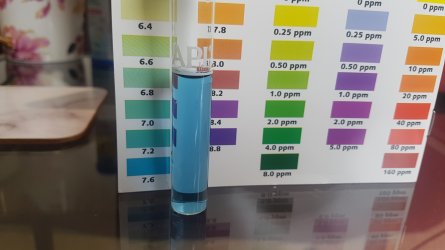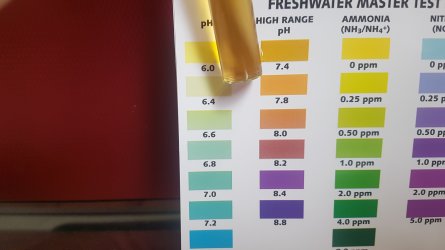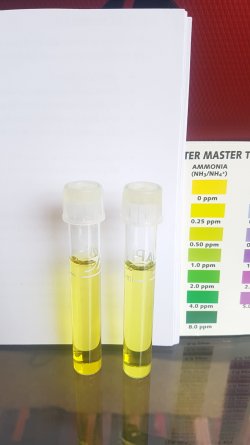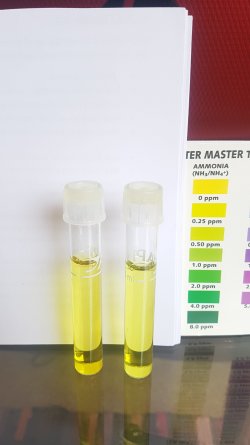Tank size: 30 litres, just an air pump filter with a spray bar, a full spectrum light for the plants and a water heater.
pH: EDIT(7.6) misread it earlier as 6.8 (see below)
ammonia: 0.25ppm
nitrite: 0ppm
nitrate: 5ppm
kH: about 60ppm (I use test strips for kH, the value is between 40-80ppm)
gH: about 70ppm (I use test strips for gH, the value is a tiny bit darker than 60ppm)
tank temp: 24 degrees C
Weekly water change of 25-30% (volume depends on dirtyness tbh)
Dosed weekly with Flourish seachem for the plants, no other added chemicals apart from the water conditioner (Bioactive Tapsafe plus).
My planted nano-tank is new, as in I set it up in late March, cycled (fishless) through to mid-April, added plants and then added 5x dwarf cherry shrimp, 3x Amano shrimp and 2x horned Nerite snails. I then waited a month (3 weeks), before last Tuesday (12/05/20) I added 5 male guppies, delivered from a well-known UK fish store. They all looked healthy and settled in to the tank well after acclimation, displaying typical guppy behaviour and feeding well (Hikari micro pellets and veg).
This morning I noticed that the largest male had something sticking out of his gill. It looked like a forked stick. I assumed it was a worm and research showed it was indeed and anchor worm.
I've removed the worm using forceps, luckily he is a calm guppy and allowed me to do this although I am worried about the effect of the stress on him The other fish were constantly chasing him and nipping at the worm, which is why I chose to remove it. I noticed after removal that he has another tiny stick-like object between his anal fin and his tail. Not sure if this is another worm. I can't remove it (too small to grip). Apart from this, he has no other symptoms. He's eating, pooping and behaving as normal. There is no lesion around where the worm was attached, but considering it was coming out from the gill, it was probably attached inside the gill so he may have an internal lesion. His gill looks OK from the outside.
The other fish were constantly chasing him and nipping at the worm, which is why I chose to remove it. I noticed after removal that he has another tiny stick-like object between his anal fin and his tail. Not sure if this is another worm. I can't remove it (too small to grip). Apart from this, he has no other symptoms. He's eating, pooping and behaving as normal. There is no lesion around where the worm was attached, but considering it was coming out from the gill, it was probably attached inside the gill so he may have an internal lesion. His gill looks OK from the outside.
I know now that due to the life cycle of anchor worms, and the fact that my aquarium hadn't had anything new added for 3 weeks, that he probably came with the worm already inside of him. This means that my tank might now have larvae/eggs in the water column, also the other guppies might have anchor worms too. I need to treat the whole tank, including all of the guppies. I plan on using Lice-Solve from Vetark, (formerly known as Mectinsol, contains 1.4% emamectin) and then possibly something else if the recommended two treatments of that don't work. I'm going to remove the shrimp and snails into a different tank before treatment, and return them after 48hrs, when the drug should have degraded, and after a large (50%?) water change. Will this be OK or will there still be a risk that the shrimp and snails will be affected by the drug?
Also, should I like.... tell the company that their fish had anchor worm? I don't want a refund or anything, I'm just a bit bothered that they're sending wormy fish to people.
I don't have a photo of the large worm as I acted fast. I can 100% say it was anchor worm (former marine & freshwater biologist). The smaller maybe-worm is way too small to capture on camera.
Thanks so much to anyone with advice in advance!!!!
pH: EDIT(7.6) misread it earlier as 6.8 (see below)
ammonia: 0.25ppm
nitrite: 0ppm
nitrate: 5ppm
kH: about 60ppm (I use test strips for kH, the value is between 40-80ppm)
gH: about 70ppm (I use test strips for gH, the value is a tiny bit darker than 60ppm)
tank temp: 24 degrees C
Weekly water change of 25-30% (volume depends on dirtyness tbh)
Dosed weekly with Flourish seachem for the plants, no other added chemicals apart from the water conditioner (Bioactive Tapsafe plus).
My planted nano-tank is new, as in I set it up in late March, cycled (fishless) through to mid-April, added plants and then added 5x dwarf cherry shrimp, 3x Amano shrimp and 2x horned Nerite snails. I then waited a month (3 weeks), before last Tuesday (12/05/20) I added 5 male guppies, delivered from a well-known UK fish store. They all looked healthy and settled in to the tank well after acclimation, displaying typical guppy behaviour and feeding well (Hikari micro pellets and veg).
This morning I noticed that the largest male had something sticking out of his gill. It looked like a forked stick. I assumed it was a worm and research showed it was indeed and anchor worm.
I've removed the worm using forceps, luckily he is a calm guppy and allowed me to do this although I am worried about the effect of the stress on him
I know now that due to the life cycle of anchor worms, and the fact that my aquarium hadn't had anything new added for 3 weeks, that he probably came with the worm already inside of him. This means that my tank might now have larvae/eggs in the water column, also the other guppies might have anchor worms too. I need to treat the whole tank, including all of the guppies. I plan on using Lice-Solve from Vetark, (formerly known as Mectinsol, contains 1.4% emamectin) and then possibly something else if the recommended two treatments of that don't work. I'm going to remove the shrimp and snails into a different tank before treatment, and return them after 48hrs, when the drug should have degraded, and after a large (50%?) water change. Will this be OK or will there still be a risk that the shrimp and snails will be affected by the drug?
Also, should I like.... tell the company that their fish had anchor worm? I don't want a refund or anything, I'm just a bit bothered that they're sending wormy fish to people.
I don't have a photo of the large worm as I acted fast. I can 100% say it was anchor worm (former marine & freshwater biologist). The smaller maybe-worm is way too small to capture on camera.
Thanks so much to anyone with advice in advance!!!!
Last edited:







